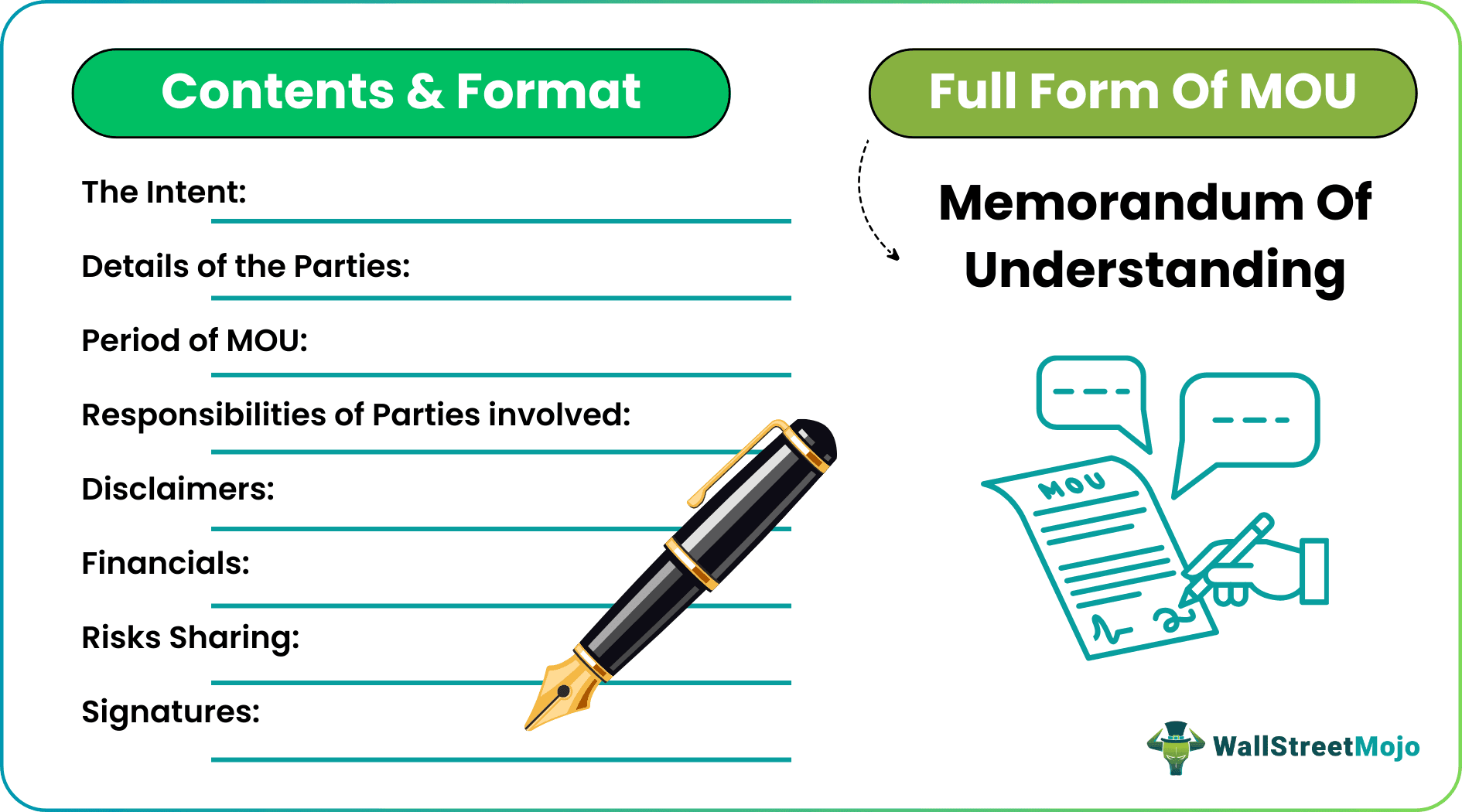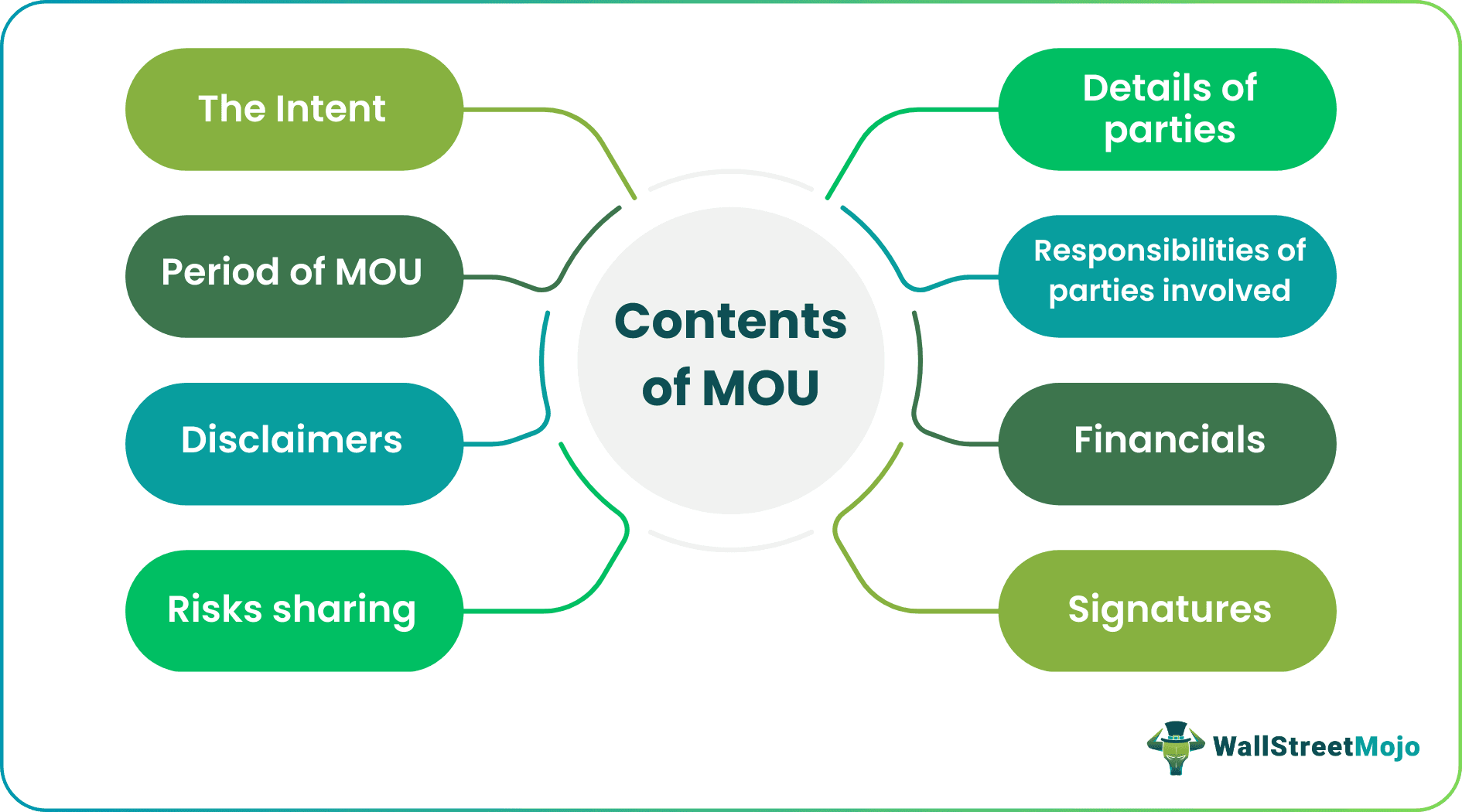Table Of Contents
Full-Form of MOU - Memorandum of Understanding
The full form of MOU stands for Memorandum of Understanding. It is an agreement between two or more parties signaling the intent of all the parties to move in a common direction concerning an action. It is not legally binding and can be construed as a step towards a formal agreement between the parties.

How Does the MOU Works?

- The memorandum of understanding sets out all the parties’ responsibilities and expectations in the document and promulgates a serious intent toward an action.
- MOUs are used extensively in international relations because they can be formulated quickly and secretly between the concerned parties. In addition, many businesses, government agencies, and departments also use MOUs to advance in the goal’s direction.
Contents and Format of MOU
When parties come forward to sign a memorandum of understanding, the talks must have reached a stage where parties know what to expect from the relationship and how to proceed in the goal’s direction. Then, each party may prepare its terms in line with their talks and develop a joint version of the MOU, considering each party’s interest in their documents.
MOUs, commonly have the following contents when drafted:

#1 - The Intent
The intent describes what the parties intend to achieve from the relationship or partnership. The intent should be straightforward with no ambiguity for ease of reference and clarity of purpose.
#2 - Details of the Parties
Each party participating in the memorandum of understanding should have themselves named in this section of the MOU. For example, they could be countries, organizations, institutions, companies, or trade bodies.
#3 - Period of MOU
It should then define the period the MOU will be valid for. If, for whatever reason, the parties cannot move in the direction of the MOU, the MOU stands ceased at the set date. A memorandum of understanding is not eternal.
#4 - Responsibilities of Parties Involved
Under this section, the responsibilities of each party lay out in detail. If there are any joint responsibilities, they should also lay here. This section should be the most detailed to clearly define what each party will do to achieve the common goal agreed to in the memorandum of understanding. This section should have details on the resources all parties expect to have and how they will contribute towards fulfilling their requisite responsibilities proposed in this part of the document.
#5 - Disclaimers
It should have adequate disclaimers laying out any responsibilities, facts, and processes from which both parties should distance themselves. One should mention any controversial arrangements in this segment for clarity.
#6 - Financials
One should lay out the proposed partnership’s financial arrangements in detail in this segment of the MOU. For example, the payments or investments made, revenue sharing done, interest to be paid, costs to be borne, etc., should be laid out in this document.
#7 - Risks Sharing
Parties should own the risks that they will bear during the partnership. The risks could be within or beyond the control of the respective parties. Irrespective of the risk’s nature, the parties should adequately cover all forms of risk in the MOU. Risks one will jointly share should also be mentioned in this segment.
#8 - Signatures
Each party or the representatives should sign the memorandum of understanding, agreeing to the terms mentioned in the MOU.
The above are the components of a basic MOU. Parties can make it more complex or simple, depending on the nature of the transaction. For example, a memorandum of understanding between two charitable institutions to share space in a building can be extremely simple. At the same time, an MOU between the two governments on their trade and commerce can be extremely complex, running into thousands of pages detailing every part of the proposed arrangement.
When to Use Memorandum of Understanding?

Parties choose to enter into MOU when they need something better than a verbal commitment and less than a formal contract. After that, it is just a formal, serious pact between parties. A memorandum of understanding can still be a step in the direction of a formal contract if the parties decide to make the partnership, which has serious implications. One could also sign it between non-profits as they are considered less threatening than the formal contract.
Purpose
The purpose of a typical MOU is layouting what the parties agreed to in a formal relationship or partnership. It is better than a verbal commitment, is documented, and can be referred to if any party strays from the path laid out in the document. In the absence of an MOU, it is hard to even mutually settle disputes during the arrangement, jeopardizing the achievement of the end goal.
Advantages
- A formal document laying out the roles and responsibilities of all the parties involved
- Better than verbal commitments
- Provides a good reference point in case of disputes
- Lays out of the intent of all the parties toward a common goal
- Convenient and easy to frame than a legally binding contract
- It is friendlier and less threatening than a formal, legally binding contract
- Makes it possible to avoid obligations under international law when countries are signing the MOUs
Disadvantages
- Absence of legally binding limits the MOU's ability to achieve the desired result
- Not all parties may believe in MOUs, in which case there could be a deadlock to talks between parties where nothing could fructify.
Conclusion
- They are widely used and considered an important starting point in bilateral and business relationships. Formally written roles, responsibilities, and risks clarify how it will approach different situations during the agreement.
- Some MOUs prove to be just as good as legal contracts. After all, parties stick to them at all times for the larger mutual benefit, while others flounder because parties do not adhere to them due to diminished viability (in which case it mutually dissolves) or due to the selfish interests of the parties involved.
